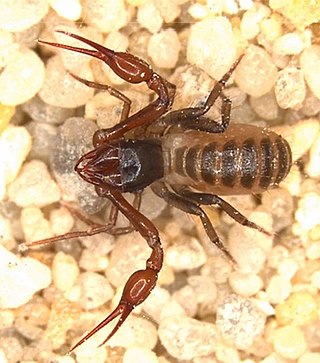
Pseudoscorpions, also known as false scorpions or book scorpions, are small, scorpion-like arachnids belonging to the order Pseudoscorpiones, also known as Pseudoscorpionida or Chelonethida.
Pseudotyrannochthonius silvestrii is a species of Chilean pseudoscorpions of the family Pseudotyrannochthoniidae. It was described in 1905 by Edvard Ellingsen, with a type locality of Santiago, Chile.

Pseudotyrannochthoniidae is a family of pseudoscorpions, belonging to the superfamily Chthonioidea. It represents the most basal and primitive group of living pseudoscorpions, with less than 100 species in 6 genera. Living members of the group have a strongly disjunct distribution, likely reflecting ancient vicariance, occurring in Australia, Asia, Southern Africa and Madagascar, Western North America and southern South America. Fossils species are known from the Eocene Baltic and Bitterfeld amber, which represent members of extant Asian genera.
Tyrannochthonius queenslandicus is a species of pseudoscorpion in the Chthoniidae family. It is endemic to Australia. It was described in 1969 by Austrian arachnologist Max Beier.

Pseudotyrannochthonius is a genus of pseudoscorpions in the family Pseudotyrannochthoniidae. It was described in 1930 by Austrian arachnologist Max Beier.
Pseudotyrannochthonius solitarius is a species of pseudoscorpion in the Pseudotyrannochthoniidae family. It is endemic to Australia. It was described in 1951 by American arachnologist Clarence Clayton Hoff.
Pseudotyrannochthonius jonesi is a species of pseudoscorpion in the Pseudotyrannochthoniidae family. It is endemic to Australia. It was described in 1962 by American arachnologist Joseph Conrad Chamberlin.
Pseudotyrannochthonius tasmanicus is a species of pseudoscorpion in the Pseudotyrannochthoniidae family. It is endemic to Australia. It was described in 1970 by Australian zoologist Alan Dartnall.
Pseudotyrannochthonius typhlus is a species of pseudoscorpion in the Pseudotyrannochthoniidae family. It is endemic to Australia. It was described in 1970 by Australian zoologist Alan Dartnall.
Pseudotyrannochthonius australiensis is a species of pseudoscorpion in the Pseudotyrannochthoniidae family. It is endemic to Australia. It was described in 1966 by Austrian arachnologist Max Beier.
Pseudotyrannochthonius bornemisszai is a species of pseudoscorpion in the Pseudotyrannochthoniidae family. It is endemic to Australia. It was described in 1966 by Austrian arachnologist Max Beier.
Pseudotyrannochthonius hamiltonsmithi is a species of pseudoscorpion in the Pseudotyrannochthoniidae family. It is endemic to Australia. It was described in 1968 by Austrian arachnologist Max Beier.
Pseudotyrannochthonius gigas is a species of pseudoscorpion in the Pseudotyrannochthoniidae family. It is endemic to Australia. It was described in 1969 by Austrian arachnologist Max Beier.

Pseudotyrannochthonius giganteus is a species of pseudoscorpion in the Pseudotyrannochthoniidae family. It is endemic to Australia. It was described in 1971 by Austrian arachnologist Max Beier.
Pseudotyrannochthonius eberhardi is a species of pseudoscorpion in the Pseudotyrannochthoniidae family. It is endemic to Australia. It was described in 1971 by arachnologists Danilo Harms and Mark Harvey. The specific epithet eberhardi honours Stefan Eberhard, who collected the holotype, for contributions to Australian karst research.
Sundochernes is a genus of pseudoscorpions in the Chernetidae family. It was described in 1932 by Austrian arachnologist Max Beier.
Sundochernes queenslandicus is a species of pseudoscorpion in the Chernetidae family. It is endemic to Australia. It was described in 1975 by Austrian arachnologist Max Beier.
Megachernes is a genus of pseudoscorpions in the Chernetidae family. It was described in 1932 by Austrian arachnologist Max Beier.
Megachernes queenslandicus is a species of pseudoscorpion in the Chernetidae family. It was described in 1948 by Austrian arachnologist Max Beier.

